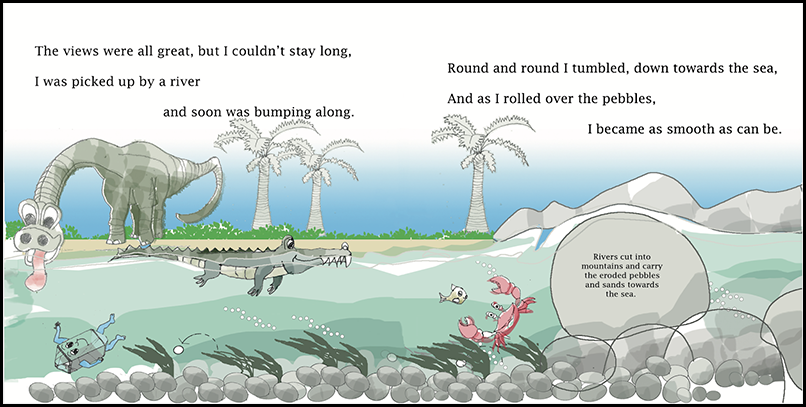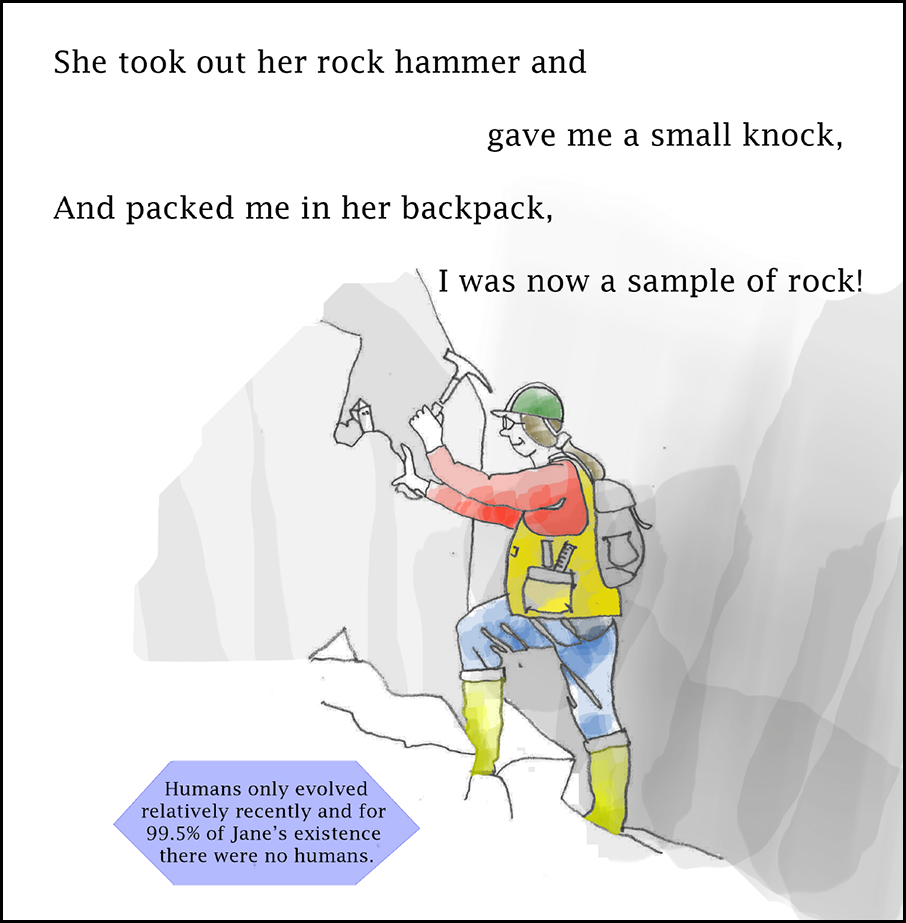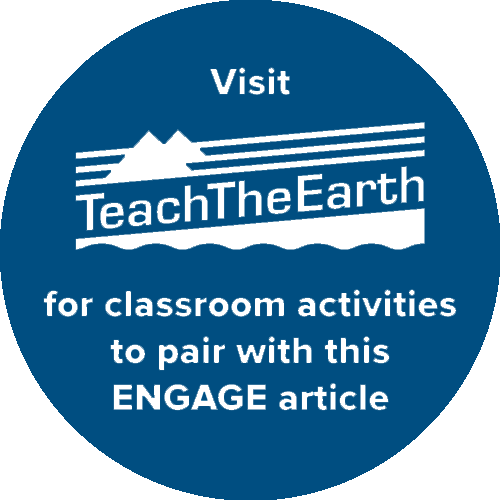There is no “once upon a time” in the children’s book Jane’s Geological Adventure, but if there were, that time was 400 million years ago, in a world replete with creepy-crawly creatures threading their way through a lush verdure of unfamiliar plants. As a volcano’s magma chamber seethed, a zircon grain named Jane was born, growing until she erupted onto Earth for a full life of metamorphism, multiple mountain-building adventures, sundry erosion styles, and her most recent phase: display at a museum.
As part of his outreach efforts, author and geochronologist Matthew Fox, a lecturer at University College London, created Jane, the zircon grain, modeling her life after rocks similar to the Jura Mountains in Switzerland. “That we can actually understand this much information from a single grain of sand is really incredible,” said Fox, “and I wanted to try to describe how we can do that.”
Jane’s Geological History
“You can think about this as a children’s book,” Fox said, or “you can think about it in terms of how you could actually extract that information from a crystal, which might require different analytical methods.” As nature’s time capsules, zircons like Jane can retain evidence of multiple high-temperature events, like the timing of crystallization or metamorphism. “That’s why we use them for geochronology,” he said.
As Jane metamorphoses, she is joined by Gary the garnet and Mitesh the mica. Although the characters are anthropomorphized, the metamorphic mineral assemblage is real. “You can look at trace element concentration within different zones to see what other minerals might have been growing at these different time intervals,” explained Fox.

The shapes of the crystal itself provide additional clues, said Fox. For example, Jane’s distinct points eroded away as she bumped along a river bottom.
After this tumultuous travel, the sediments in which she landed eventually lithified and rose skyward as mountains. From this vantage, Jane watched glaciers carve the land before being plucked from an outcrop by a geochronologist who wrings history from Jane’s lattice.
By describing the many geological processes that Jane (and, by extension, mountains like the Swiss Jura) experienced, Fox said, “you can get a sense of how much can fit into such a long period of time.”

A Family Project
Although Jane’s geological tale spans 400 million years, the book itself has a much younger provenance. After years of scribbling short geology-themed poems during field trips, Fox began to toy with writing a longer poem for children. In 2018, shortly after Fox joined University College London as a Natural Environment Research Council Independent Research Fellow, he began to compose Jane’s story on his phone, during his commute.

As Fox refined the rhyme, he reached out to several friends and colleagues, many of whom worked on zircon-related quandaries (including the author of this article). With the support of his community, Fox became convinced that a children’s book was worth pursuing. However, without funds to pay for an illustrator, he was stuck.
At this point, the project became a true family affair. Fox’s mother contributed indirectly to the story because Jane is her namesake. Fox proposed a collaboration to his father, Martin Fox, an architect and occasional painter, who agreed to help. Fox the elder created a playfully anthropomorphic, but scientifically precise, depiction of Jane’s journey, while Fox the younger ensured the details were correct—for example, that only dinosaurs from the same era feature in Jane’s story.
Connecting with Kids and Parents
As the Fox family worked to illustrate Jane’s exploits, Matthew Fox began looking forward to fatherhood himself. Fox’s daughter was born soon after he finished the book and just as the COVID-19 pandemic began in spring 2020.

The pandemic thwarted Fox’s plan to sell the book at conferences to eschew postage. He opted to sell the book via his website instead, publishing the first 200 copies during parental leave. “[Fatherhood] made me appreciate how important children’s books are and how important that time is where you actually interact with children,” said Fox. “My partner says it’s one of [my daughter’s] favorite books.”
Structural engineer Jan Moore of Salt Lake City, Utah, said that Jane’s appeal is not limited to children. “[My kids] really got the idea [that] the dinosaurs existed at one time and not another, which I thought was an advanced idea that kids don’t always grasp,” she said. “I don’t think I really grasped what the age [of a rock] really meant until there was a children’s book to explain it.”
Creative Public Outreach
When it comes to public outreach, said Fox, “everyone’s got different skills.” For example, although he’s spoken at schools around London, he acknowledges that public speaking sometimes makes him nervous.
“Try and do outreach activities that you enjoy doing.”
He had a different approach to the book. “This was something that I quite enjoyed doing…and I thought I could contribute to outreach in a way that might be potentially more far-reaching,” Fox said. He plans to donate any profits made from the sales of Jane’s Geological Journey to GeoBus, an outreach activity funded by the U.K. Natural Environment Research Council wherein a van brimming with activities designed to engage children in geology travels to different schools.
To other researchers trying expand their outreach, Fox offered some tried-and-true advice: “Try and do outreach activities that you enjoy doing.” If the outreach you’re doing is something you’re excited about, he said, people will respond to that.
—Alka Tripathy-Lang (@DrAlkaTrip), Science Writer
This news article is included in our ENGAGE resource for educators seeking science news for their classroom lessons. Browse all ENGAGE articles, and share with your fellow educators how you integrated the article into an activity in the comments section below.
Citation:
Tripathy-Lang, A. (2021), Meet Jane, the zircon grain—geochronology’s new mascot, Eos, 102, https://doi.org/10.1029/2021EO162514. Published on 27 August 2021.
Text © 2021. The authors. CC BY-NC-ND 3.0
Except where otherwise noted, images are subject to copyright. Any reuse without express permission from the copyright owner is prohibited.



